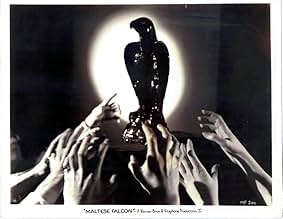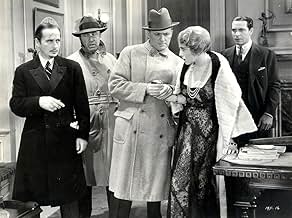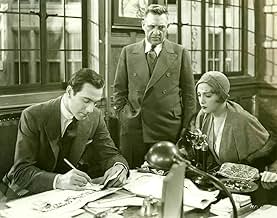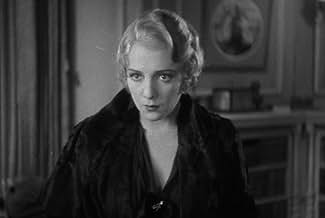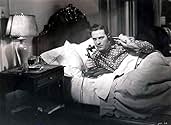Aggiungi una trama nella tua linguaA lovely dame with dangerous lies employs the services of a private detective, who is quickly caught up in the mystery and intrigue of a statuette known as the Maltese Falcon.A lovely dame with dangerous lies employs the services of a private detective, who is quickly caught up in the mystery and intrigue of a statuette known as the Maltese Falcon.A lovely dame with dangerous lies employs the services of a private detective, who is quickly caught up in the mystery and intrigue of a statuette known as the Maltese Falcon.
- Regia
- Sceneggiatura
- Star
- Premi
- 2 vittorie totali
- Capt. John Jacobi
- (non citato nei titoli originali)
- Jailbird Seeking Cigarette
- (non citato nei titoli originali)
- Baggage Clerk
- (non citato nei titoli originali)
- District Attorney
- (non citato nei titoli originali)
- Sarah - Prison Matron
- (non citato nei titoli originali)
Recensioni in evidenza
In a nutshell, THE MALTESE FALCON told the story about a San Francisco private detective named Sam Spade, who finds himself drawn into a search for a valuable falcon statuette first created during the Crusades, while investigating three murders.
The story began with a Miss Ruth Wonderly hiring Spade and his partner, Miles Archer, to find her missing sister and a man named Floyd Thursby. When Thursby and Archer end up murdered, Spade discovered that Miss Wonderly is one of three people searching for a statuette called the Maltese Falcon. A mortally wounded ship's captain delivered the statuette to Spade's office before dropping dead, making him the case's third murder victim. The entire case spiraled into a game of cat-and-mouse between Spade, Miss Wonderly, a wealthy fat Englishman named Caspar Gutman and an effeminate continental European named Dr. Joel Cairo. Spade also had to deal with the police, who are determined to pin the three deaths on him.
In the end, this version turned out better than I had expected. However, the movie is not without its faults. There were times when I felt I was watching a filmed play (very common with early talking movies). But the film's main problem seemed to be its pacing. It seemed too slow for what was supposed to be a witty murder mystery. Especially during the first half hour. By the time Joel Cairo was introduced into the story, the pacing finally began to pick up. The dialogue provided by screenwriters Maude Fulton, Brown Holmes and an unaccredited Lucien Hubbard failed to improve over the course of the movie. Not only did the screenplay allow the dialogue to drag throughout the entire film, the latter was not that memorable.
Considering that this is the only precode version of the film, it is not surprising that this version is considered the sexiest of the three filmed versions of the novel. Del Ruth, along with Fulton, Holmes and Hubbard, did an excellent job of conveying the womanizing aspect of Spade's character by revealing his affairs with Archer's wife Iva, his casual flirtation with his secretary Effie, and visual hints of his relationship with Ruth Wonderly like a small indent in the pillow next to the client's head, which hinted that Spade had spent the night with her. Other signs of precode sexuality included Spade bidding a female client good-bye at the beginning of the movie, a nude Miss Wonderly in a bathtub, and a hint of a homosexual relationship between Caspar Gutman and his young enforcer Wilmer Cook.
This version lacked the sharp wit of the 1941 adaptation. Considering that I have never read the novel, the screenplay did allow me to completely understand the story in full detail for the first time, without leaving me in a slight haze of fog. I found nothing memorable about William Rees' photography or Robert M. Haas' art direction except in one scene. The scene in question featured an exterior setting, namely a street in San Francisco's Chinatown where Miles Archer's body was discovered. I suspect that this particular scene gave both Rees and Haas an opportunity to display their artistry beyond the movie's usual interior settings.
There is also a solid cast here. Ricardo Cortez, led the cast as detective Sam Spade. Cortez gave a very sexy interpretation of Spade in his performance. His constant smirks and grins in the film's first ten to fifteen minutes seemed annoying. But in the end, Cortez grew on me. I can honestly say that not only did I find him very effective in portraying a sexy Sam Spade, he also managed to superbly capture the character's cynical humor, toughness and deep contempt toward the police.
Bebe Daniels, another survivor from the silent era, portrayed Ruth Wonderly, and this role has to be considered as one of her best. She managed to give an excellent performance as the ladylike yet manipulative woman who drew Spade into the labyrinth search for the Maltese Falcon. Mind you, she lacked Mary Astor's throbbing voice and nervous manner. But that is merely a minor hitch. Daniels still managed to portray a very convincing elegant temptress.
Irish-born Dudley Digges portrayed the wealthy and obsessive Caspar Gutman, who is not above murder, bribery and a score of other crimes to acquire the falcon statuette. Digges lacked the style to believably portray a man wealthy enough to conduct a twenty-year search for a valuable artifact. Instead, Digges reminded me of a corrupt minor official at a British post in the tropics. He seemed to lack talent and subtlety for infusing menace into his character. Whenever he tried to menacing, he only ended up giving a hammy performance. On the other hand, Otto Matieson gave a more believable performance as Dr. Joel Cairo, Gutman's Continental accomplice. Matieson portrayed Cairo as a no-nonsense and practical man who is careful with his money and with whom to trust it.
Una Merkel gave a humorous performance as Spade's Girl Friday, Effie. Her Effie is not hesitant about expressing her attraction to Spade, yet at the same time, she seemed to find the detective's other amorous activities rather amusing. Todd seemed to be trying too hard as a scorned lover without any subtlety. At least Dwight Frye fared better as Gutman's young enforcer, Wilmer Cook. He did a solid job in conveying the portrait of a baby-faced killer.
I'd suggest watching the 1931 version and the 1941 versions back to back, to get an idea of how Warner Brothers "grew up" during the 1930s. Remember they were just a poverty row studio mainly known for their Rin Tin Tin silent until The Jazz Singer made them rich.
As in "Satan Met a Lady", the detective is made out to be a sleazy ladies' man in this movie. When we first see him, he's kissing a woman goodbye; we never actually see her face, but we see her adjusting her stocking, and when Sam returns to his office, the pillows from his couch are in disarray. He seems to be getting some from Effie as well (and I must point out that Una Merkel, as Effie, is hot, hot, hot in this movie; quite a contrast to the matronly Lee Patrick in the 1941 version).
Overall, though, this movie is still somewhat unsatisfying. I suppose if we had never seen the Bogart/Huston version, this would stand as an acceptable adaptation of Hammett's novel (by the standards of the time). It follows the novel fairly closely, but skimps on the plot somewhat. The subplot where Wonderley disappears, and then reappears (as O'Shaughnessy) because she realizes Gutman is in town is missing, as is all the great interplay between Spade and Wilmer ("Just keep riding me, buster", "This'll put you in solid with your boss", etc.) that was such a treat in the later version. True, this movie is a little more explicit about the relationship between Gutman and Wilmer, but Wilmer is such a minor character (with literally only a few minutes of screen time) that their relationship still seems more fully-developed in the 1941 movie. There's also a very odd change at the end (just before the prison scene) that seems like something of a cop-out.
And, finally, it must be pointed out that Ricardo Cortez really stinks in this movie. He spends most of the movie with a smirk plastered on his face, and his performance in general is extremely stiff. I suppose that's to be expected in such an early talkie, but, combined with the general aura of sleaziness that his character exudes, it makes it impossible to really care what happens to him. In the end, this is an enjoyable movie, but mainly for reasons of historical curiosity, and it never comes anywhere near the "classic" status that the later remake has achieved.
I found this version slow going, mainly because it's an early talkie - the dialogue pacing isn't quite right. You can drive a truck through the pauses. The only one with a more modern feel for the dialogue is the handsome, smiling Cortez, and he's absolutely marvelous as Spade. His Spade is more relaxed than Bogie's, less sardonic, more delightfully crooked - in short, he has a lot more fun. He fits just as well into this version as world-weary Bogie does into the 1941 version.
Bebe Daniels is attractive and alluring as the greedy and totally ruthless Miss Wonderly. The gay subplot between Greenstreet and Lorre everyone assumes isn't as apparent in this film between Wilmer (Dwight Frye) and Caspar Guttman (Dudley Digges).
I found the comments in the first post on the actors' approaches to their roles very interesting; I'm not sure I totally agree, but for sure, Cortez spoke louder and Daniels did underplay (which she did not do in "42nd Street" - at all). However, as far as the pace, I still Cortez did better in keeping the dialogue going than anyone else.
This is a fascinating film - so different from the 1941 version, which I hope to see this evening - it's definitely worth catching.
DANGEROUS FEMALE is interesting in several ways, and perhaps most deeply so as an example of the struggle that ensued when sound first roared. What had proved effective on the silent screen suddenly seemed highly mannered when voices were added, and both directors and stars struggled to find new techniques--and DANGEROUS FEMALE offers a very vision of the issues involved.
It is a myth that the advent of sound forced directors to lock down the camera, but it is true that many directors preferred simple camera set-ups in early sound films; it gave them one less thing to worry about. And with this film, Roy Del Ruth is no exception: in a visual sense, DANGEROUS FEMALE is fairly static. The performing decisions made by the various actors are also illustrative and informative, particularly re leads Ricardo Cortez and Bebe Daniels. Cortez is still clearly performing in the "silent mode," and he reads as visually loud; Daniels, however, has elected to underplay, and while she is stiff by current standards, her performance must have seemed startlingly innovative at the time. And then there are two performers who are very much of the technology: Una Merkle as Spade's secretary and Thelma Todd as Iva Archer, both of whom seem considerably more comfortable with the new style than either Cortez or Daniels.
The film is also interesting as a "Pre-Code" picture, for it is sexually explicit in ways most viewers will not expect from a 1930s film, and indeed it is surprisingly explicit even in comparison to other pre-code films. Hero Sam Spade is a womanizer who seduces every attractive female who crosses his path--and the film opens with a shot of just such a woman pausing to straighten her stockings before leaving his office. Still later, the dubious Miss Wonderly tempts Spade with her cleavage, lolls in his bed after a thick night, splashes in his bathtub, and finally winds up stripped naked in his kitchen! It is also interesting, of course, to compare DANGEROUS FEMALE to its two remakes. Directed by William Dieterle and starring Warren William and Bette Davis, the 1936 Satan MET A LADY would put Hammett's plot through the wringer--and prove a critical disaster and a box office thud. But then there is the justly celebrated 1941 version starring Humphrey Bogart and Mary Astor under the direction of John Huston.
Both the 1931 and 1941 films lifted great chunks of dialogue from Hammett's novel, and very often the dialogue is line-for-line the same. But two more completely different films could scarcely be imagined. Where the 1931 film strives for an urbane quality, the 1941 film is memorably gritty--and in spite of being hampered by the production, considerably more sexually suggestive as well, implying the homosexuality of several characters much more effectively than the 1931 version dared.
In the final analysis, the 1931 THE MALTESE FALCON (aka DANGEROUS FEMALE) will appeal most to those interested in films that illustrate the transition between silent film and sound, to collectors of "pre-code" movies, and to hardcore FALCON fans who want everything associated with Hammett, his novel, and the various film versions. But I hesitate to recommend it generally; if you don't fall into one of those categories, you're likely to be unimpressed.
Gary F. Taylor, aka GFT, Amazon reviewer
Lo sapevi?
- QuizArt director Robert M. Haas performed the same function on Il mistero del falco (1941).
- BlooperThe same prop is used for the suitcase that Spade finds in Miss Wonderly's room and the suitcase which contains the falcon. The travel stickers are identical on each one.
- Citazioni
Effie Perrine: Sam, it's a gorgeous new customer.
Sam Spade: Gorgeous?
Effie Perrine: A knockout.
Sam Spade: Send her right in, honey.
Effie Perrine: [to the off-screen customer] Will you step in, please?
[Joel Cairo walks in.]
- ConnessioniFeatured in Great Performances: Bacall on Bogart (1988)
I più visti
- How long is The Maltese Falcon?Powered by Alexa
Dettagli
- Data di uscita
- Paese di origine
- Lingue
- Celebre anche come
- The Maltese Falcon
- Luoghi delle riprese
- Azienda produttrice
- Vedi altri crediti dell’azienda su IMDbPro
- Tempo di esecuzione
- 1h 20min(80 min)
- Colore

